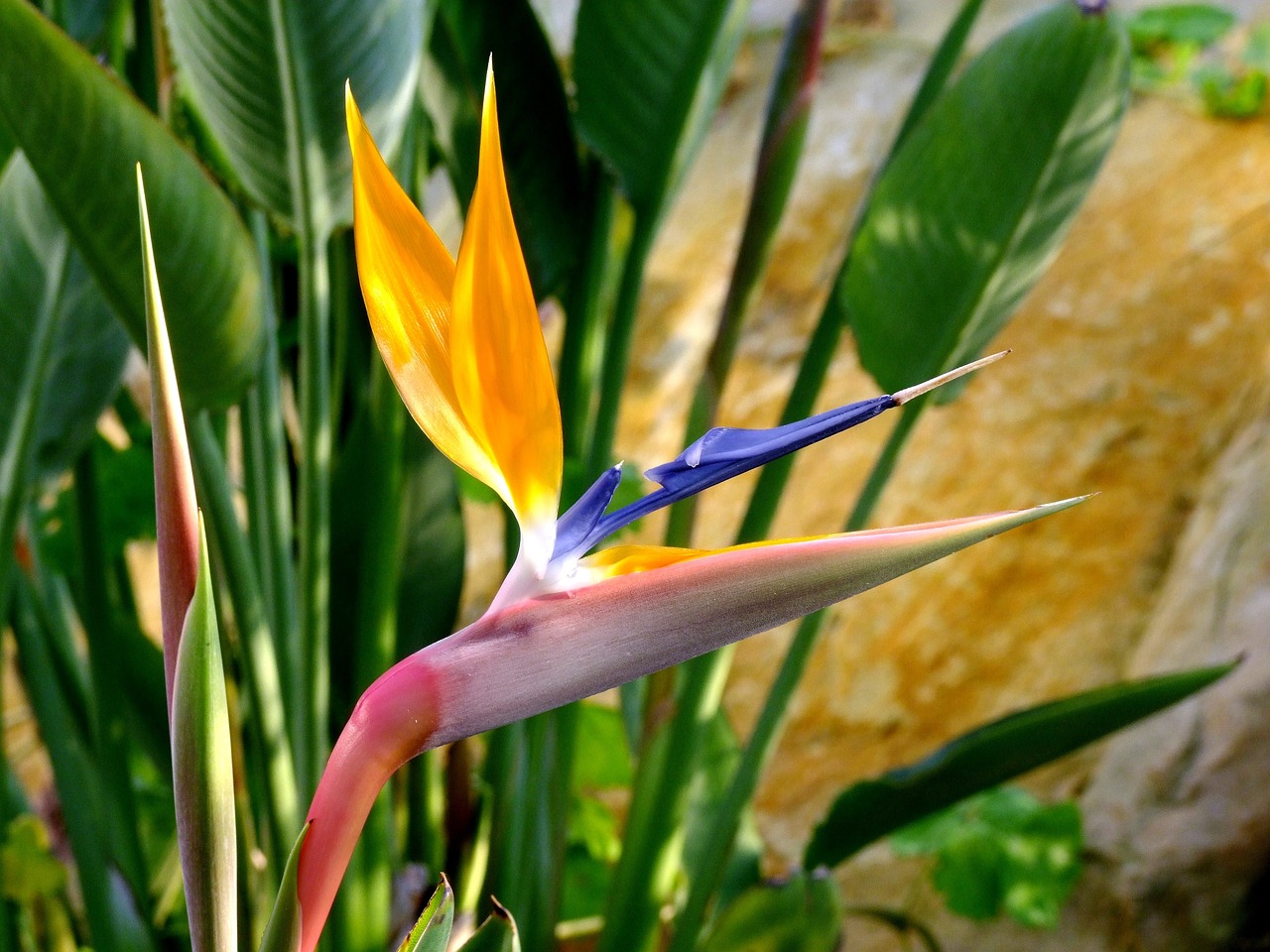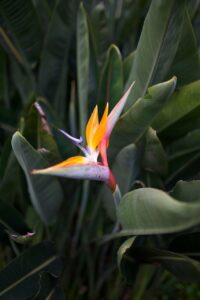Bird of Paradise
Overview
The Strelitzia reginae, or Bird of Paradise, is a perennial known for its striking orange and blue blooms. Native to South Africa, it flourishes in warm climates and makes a bold statement in any garden or as a decorative indoor plant. Its foliage and unique flowers offer ornamental charm coupled with a touch of exotic flair.

Characteristics
Known for its striking orange and blue flowers resembling a bird in flight, architectural leaves, and tropical origins.
Region
Native to South Africa, it thrives in warm climates and is commonly grown in USDA hardiness zones 10-11.
Natural Habitat
The Bird of Paradise is typically found in the wild in coastal scrub and riverine bush.
Cultivation
Prefers indirect sunlight, needs consistently moist soil with good drainage, and thrives in warm climates.
Uses and Benefits
The Strelitzia reginae plant, known for its striking beauty, is not only a visual delight but also serves practical purposes in our homes and gardens. Here are some of the uses and benefits:
- Ornamental Beauty: With its bold, crane-like orange and blue flowers and large leaves, it adds an exotic touch to landscaping and indoor decor.
- Air Quality Improvement: As a houseplant, the Bird of Paradise may contribute to better indoor air quality by filtering out pollutants.
- Symbolic Plant: Historically, it symbolizes joyfulness and paradise itself, which can be a meaningful addition to gardens or as gifts 1.
- Therapeutic Presence: Having plants around is known to improve mental health by reducing stress levels and promoting a sense of well-being.
Not to be used solely for its looks, the Bird of Paradise plays a role in bringing a touch of nature’s serenity into our daily lives.

Cultivation Tips
Cultivating a healthy Strelitzia reginae, commonly called Bird of Paradise, can be a rewarding experience with its display of unique and vibrant blooms. For successful growth, keep in mind these crucial tips:
- Ensure you plant in well-draining soil to prevent waterlogging, which could damage roots and encourage disease4.
- Position your Bird of Paradise in a spot where it can receive ample indirect sunlight, aiding in the development of its signature flowers4.
- The temperature should ideally be maintained around 80 degrees Fahrenheit or warmer to mimic its tropical origins4.
- Although the plant likes moisture, avoid the soil becoming soggy. Aim for a balance by checking that the top layer is slightly dry before watering4.
- For propagation via seeds, lightly nick the outer coating of the seed to enhance germination, then plant the seeds about 1/2 to 1 inch deep with a separation of at least 3 inches4.
- Use a cloche or plastic wrap to cover the pot during seed germination to keep the soil consistently moist4.
With proper care, your Bird of Paradise can become a lush, tropical centerpiece, bringing a touch of exotic elegance to your home or garden.
Seasonal Considerations
Caring for your Strelitzia reginae requires a keen understanding of its seasonal needs. As a perennial best suited for USDA hardiness zones 10 to 113, its robust nature can withstand variations in weather, but it thrives during certain times of the year.
- In spring, focus on consistent watering as this season marks the beginning of its growth period.
- Summer demands diligent attention to soil moisture; avoid overwatering to prevent root rot.
- During fall, reduce watering frequency as the plant’s growth slows.
- Winter can be challenging; protect the plant from frost and provide bright, indirect light.
By tailoring care with the seasons, your Bird of Paradise can flourish, producing its iconic blooms.

Issues and Troubleshooting
Common issues you may encounter with the Strelitzia reginae, or Bird of Paradise, include:
- Inadequate Blooming: If your plant is not blooming, it may be due to insufficient light or the plant’s age. Ensure it gets bright, indirect sunlight and be patient—blooming typically begins when the plant is at least 4-5 years old.
- Pest Infestations: Spider mites and scale can be a problem; inspect your plant regularly and treat it with insecticidal soap or neem oil if pests are present.
- Root Rot: This happens when the soil remains too wet. Make sure the potting mix is well-draining and avoid overwatering.
- Leaf Discoloration: Yellow leaves can signal overwatering, while brown tips might indicate low humidity or too much direct sunlight. Adjust watering practices and plant placement accordingly.4
Monitor your plant’s environment and health regularly, and adjust care as needed for a thriving Bird of Paradise.
History and Folklore
The Strelitzia reginae, more commonly known as the Bird of Paradise, carries a royal legacy from the 18th century. Sir Joseph Banks, presiding over the Royal Botanic Gardens in Kew, named this vibrant plant to honor Queen Charlotte— the Duchess of Mecklenburg-Strelitz1. Its resemblance to the plumage of tropical birds and the courtly connection bestows upon it a noble stance in the horticultural realm. This historical backdrop adds to the allure of the Bird of Paradise as more than just an eye-catching ornamental plant.
Its majestic blossoms and regal roots continue to captivate the imaginations of enthusiasts and gardeners worldwide.
References
1. House Digest, “Bird Of Paradise: Everything You Should Know Before Planting,” https://www.housedigest.com/730734/bird-of-paradise-everything-you-should-know-before-planting/
2. Wikipedia, “Strelitzia reginae,” https://en.wikipedia.org/wiki/Strelitzia_reginae
3. IFAS, “FPS-563/FP563: Strelitizia reginae Bird of Paradise,” https://edis.ifas.ufl.edu/publication/FP563
4. The Spruce, “Bird of Paradise: Plant Care & Growing Guide,” https://www.thespruce.com/how-to-grow-strelitzia-1902742
5. Britannica, “Bird-of-paradise flower | Description & Facts,” https://www.britannica.com/plant/bird-of-paradise-flower
Image Credit: ADD
Image Credit: blueMix
Image Credit: Alexas_Fotos
Nicolas Duval
Nicolas is a passionate advocate for nature and the art of wildcrafting. His dedication shines through in Wildcraftia, a website he meticulously crafted to serve as a haven for nature enthusiasts worldwide. Driven by a deep appreciation for nature’s connection to humanity, Nicolas embarked on his journey in 2011 with SmokableHerbs, a platform showcasing his love for nature’s bounty. Building upon this foundation, he established Smokably, a thriving online store offering premium herbs and blends to a global audience.
